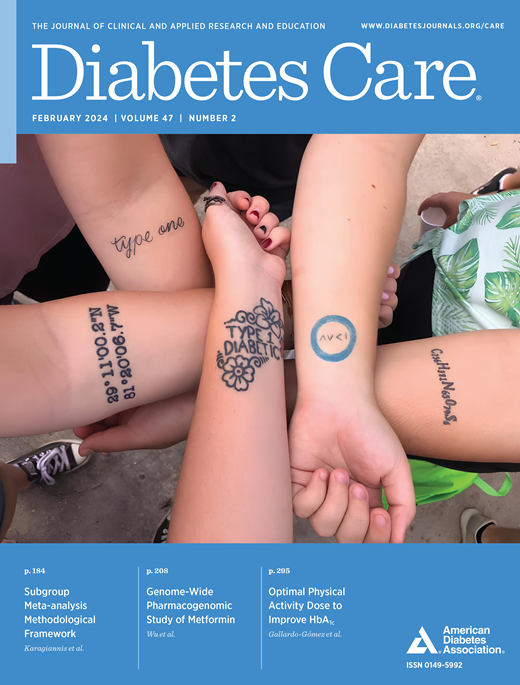Maternal Glycemic Status and Longitudinal Fetal Body Composition and Organ Volumes Based on Three-Dimensional Ultrasonography
IF 14.8
1区 医学
Q1 ENDOCRINOLOGY & METABOLISM
引用次数: 0
Abstract
OBJECTIVE Gestational diabetes mellitus (GDM) increases the risk of fetal overgrowth as measured by two-dimensional ultrasonography. Whether fetal three-dimensional (3D) soft tissue and organ volumes provide additional insight into fetal overgrowth is unknown. RESEARCH DESIGN AND METHODS We prospectively evaluated longitudinal 3D fetal body composition and organ volumes in a diverse US singleton pregnancy cohort (2015–2019). Women were diagnosed with GDM, impaired glucose tolerance (IGT), or normal glucose tolerance (NGT). Up to five 3D ultrasound scans measured fetal body composition and organ volumes; trajectories were modeled using linear mixed models. Overall and weekly mean differences in fetal 3D trajectories were tested across glycemic status, adjusted for covariates. RESULTS In this sample (n = 2,427), 5.2% of women had GDM, and 3.0% had IGT. Fetuses of women who developed GDM compared with NGT had larger fractional arm and fractional fat arm volumes from 26 to 35 weeks, smaller fractional lean arm volume from 17 to 22 weeks, and larger abdominal area from 24 to 40 weeks. Fetuses of women with IGT had similar growth patterns, which manifested later in gestation and with larger magnitudes, and had larger fractional lean arm volume. No overall differences were observed among thigh or organ volumes across glycemic status. CONCLUSIONS Body composition differed in fetuses of GDM-complicated pregnancies, including larger arm and abdominal measures across the second and third trimesters. Patterns were similar in IGT-complicated pregnancies except that they occurred later in gestation and with larger magnitudes. Future research should explore how lifestyle and medication may alter fetal fat accumulation trajectories among hyperglycemic pregnancies.基于三维超声波成像的母体血糖状态与胎儿纵向身体成分和器官体积
目的 通过二维超声造影测量,妊娠糖尿病(GDM)会增加胎儿过度发育的风险。胎儿三维(3D)软组织和器官体积是否能提供胎儿过度生长的更多信息尚不清楚。研究设计和方法 我们在一个多样化的美国单胎妊娠队列(2015-2019 年)中对纵向三维胎儿身体成分和器官体积进行了前瞻性评估。妇女被诊断为 GDM、糖耐量受损 (IGT) 或糖耐量正常 (NGT)。多达五次的三维超声扫描测量了胎儿的身体成分和器官体积;使用线性混合模型对轨迹进行建模。对不同血糖状态下胎儿三维轨迹的总体和每周平均差异进行了测试,并对协变量进行了调整。结果 在该样本(n = 2,427)中,5.2% 的妇女患有 GDM,3.0% 患有 IGT。与 NGT 相比,患 GDM 的妇女所怀的胎儿在 26 至 35 周时手臂和脂肪部分体积较大,在 17 至 22 周时瘦臂部分体积较小,在 24 至 40 周时腹部面积较大。胰岛素抵抗妇女的胎儿具有相似的生长模式,在妊娠后期表现出来,而且幅度更大,瘦臂分数体积也更大。不同血糖状态的胎儿的大腿或器官体积没有整体差异。结论 GDM 并发症妊娠胎儿的身体成分存在差异,包括在第二和第三个妊娠期手臂和腹部体积较大。IGT合并妊娠的胎儿也有类似的模式,只是发生在妊娠晚期且幅度更大。未来的研究应探讨生活方式和药物如何改变高血糖孕妇的胎儿脂肪堆积轨迹。
本文章由计算机程序翻译,如有差异,请以英文原文为准。
求助全文
约1分钟内获得全文
求助全文
来源期刊

Diabetes Care
医学-内分泌学与代谢
CiteScore
27.80
自引率
4.90%
发文量
449
审稿时长
1 months
期刊介绍:
The journal's overarching mission can be captured by the simple word "Care," reflecting its commitment to enhancing patient well-being. Diabetes Care aims to support better patient care by addressing the comprehensive needs of healthcare professionals dedicated to managing diabetes.
Diabetes Care serves as a valuable resource for healthcare practitioners, aiming to advance knowledge, foster research, and improve diabetes management. The journal publishes original research across various categories, including Clinical Care, Education, Nutrition, Psychosocial Research, Epidemiology, Health Services Research, Emerging Treatments and Technologies, Pathophysiology, Complications, and Cardiovascular and Metabolic Risk. Additionally, Diabetes Care features ADA statements, consensus reports, review articles, letters to the editor, and health/medical news, appealing to a diverse audience of physicians, researchers, psychologists, educators, and other healthcare professionals.
 求助内容:
求助内容: 应助结果提醒方式:
应助结果提醒方式:


